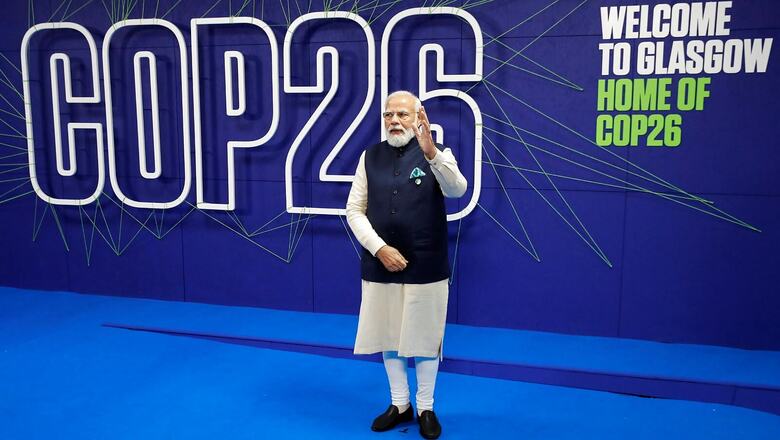
views
Posing a daunting challenge to India’s ambitious push for renewable energy, climate change is all set to adversely impact the country’s solar and wind energy potential over the next 50 years, according to a new analysis led by scientists at Indian Institute of Tropical Meteorology (IITM), Pune.
The future projections are significant as India sets out on its mission to meet as much as 50 per cent of its energy requirements from renewable energy by 2030. Making one of the boldest new commitments at COP26 Glasgow last November, Prime Minister Narendra Modi had vowed to take the country’s renewable energy capacity to 500 GW, of which 300 GW is to be met through expansion of solar energy projects.
Fall in Solar Potential
According to the latest study published in journal Current Science, solar potential is likely to decrease over most part of the Indian landmass in the near future. In fact, solar radiation is estimated to decrease by 10–15 Wm–2 over the next 50 years during all seasons, showed the future projections. While the reasons may be varied, an increase in the total cloud cover is being considered a significant factor, which can reduce the frequency of solar radiation.
North-western India, where the maximum number of solar farms are located, showed a fall in solar radiation throughout the year, except for the pre-monsoon months, when it reels under a scorching summer. Ladakh, Himachal Pradesh and Uttarakhand emerged as the only regions which showed an increase in future solar projections. According to the team, central and south-central India could be more favourable for future investment in the solar power sector in the pre-monsoon months, as the potential loss is minimum in these regions.
“The aim of the study was not to raise alarm, but to make the stakeholders aware that climate change is indeed expected to impact future renewable energy production. So, it is paramount that climate factor is taken into account while planning their strategy and investment,” said Dr P Mukhopadhyay, senior scientist at IITM Pune while talking to News18.
“These projections are emerging not just from one or two models, but an ensemble of global climate models assessed as part of IPCC. So, they are significant and robust. Also, no matter which future scenario we put them through, all three sets of models were unanimous in pointing at a decrease in the potential of wind and solar in India.”
The team, also including fellow scientists TS Anandh and Deepak Gopalakrishnan, used an ensemble of global and regional climate models — six CORDEX-SA, 13 CMIP5 and 13 CMIP6 models — to examine the historical trends of renewable energy sources in the past five decades and see how they will be available in the future over the Indian subcontinent. All different kind of climate scenario projections shared by IPCC in its latest report were used to ascertain the future trends.
Fall in Wind Energy Potential
India mainly receives majority of its wind energy during the southwest monsoon and solar energy during the pre-monsoon season. Previous climatic analysis has reported that the wind potential over India is likely to be affected because of the Indian Ocean warming.
While the study showed a clear sign of an overall decreasing wind energy potential, there were strong regional and seasonal variations. There was an increase in the seasonal and annual wind speed over South India and decrease over North India.
According to the team, the onshore regions would still perform better, especially, the southern coast of Odisha and the southern Indian states of Andhra Pradesh and Tamil Nadu which showed promising potential for wind energy in the climate change scenario. The seasonal analysis indicates that the southern and north-western regions of the country will have higher wind speed in the winter and monsoon months when the wind potential is maximum. But the wind potential is likely to go down during the non-monsoon months for the offshore regions.
Furthermore, the wind potential showed that the frequency of high energy-producing wind speeds will decrease, whereas low energy- producing wind speeds are likely to increase in the future.
Become Climate Smart
Unlike hydroelectric power, which shows a promising future over the Indian landmass with increased potential in climate projections, scientists assert that wind and solar energy are sensitive to even small changes in atmospheric conditions and therefore, to climate change.
“Our industry must become climate smart, and our technologies must evolve accordingly. Such projections must be viewed with possibility rather than certainty. And, here is a clear possibility that efficiency of renewable energy will be hit due to climate change, and we need to be prepared,” added Mukhopadhyay.
The growth of renewable energy is paramount if the world is to meet climate goals and limit warming. In 2018 alone, renewable energy accounted for more than 25% of the world’s energy production, which is expected to reach up to 80% by 2050.
In India, renewable energy generation supported 23% of energy production in 2019 and this is expected to increase up to 40% in 2030. The findings can help the industry to carefully plan their investments, which are expected to significantly increase in the next 30–40 years.
According to the study, the country could also look at expanding and building more efficient networks of wind and solar farms to increase renewable energy production which will not only help India meet its climate goals, but also meet growing energy demands in future.
Read all the Latest News , Breaking News and IPL 2022 Live Updates here.


















Comments
0 comment